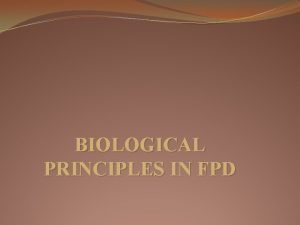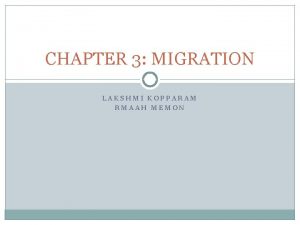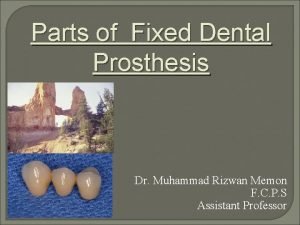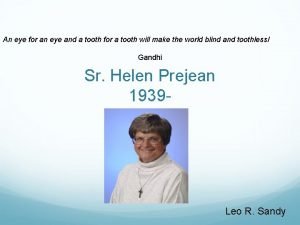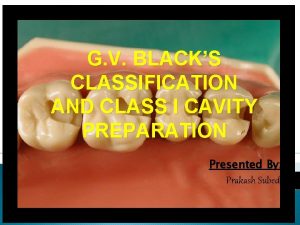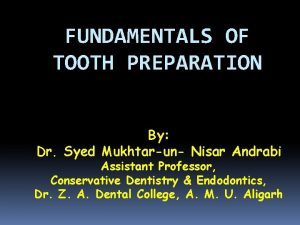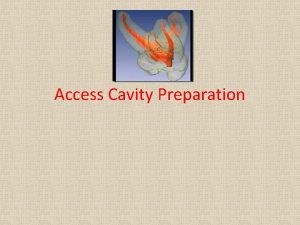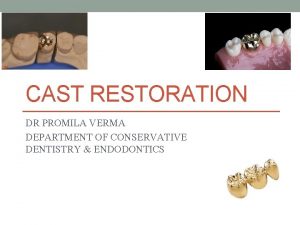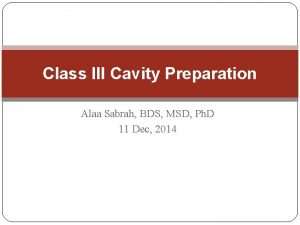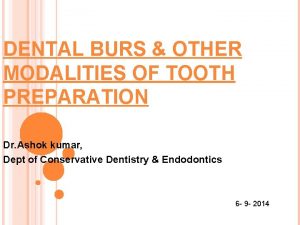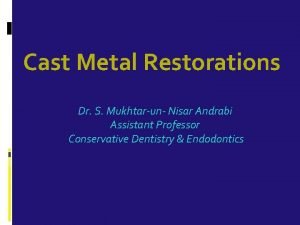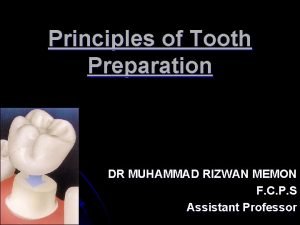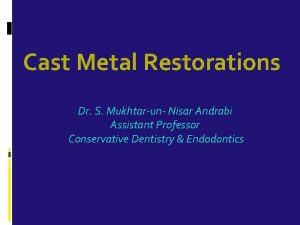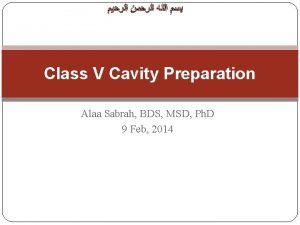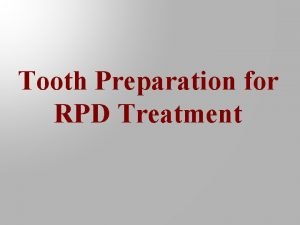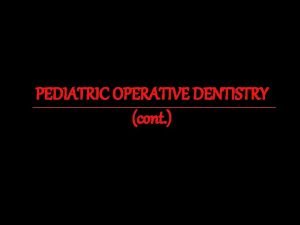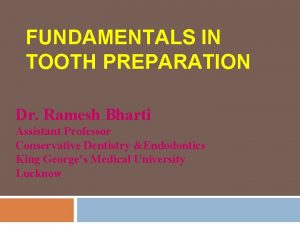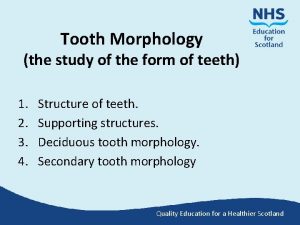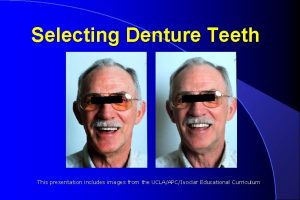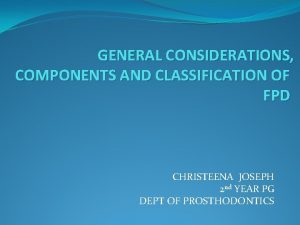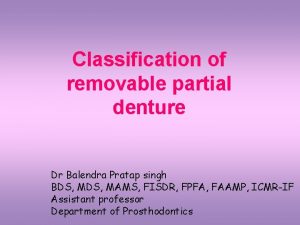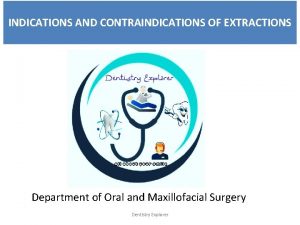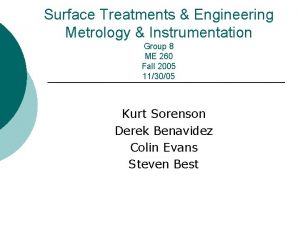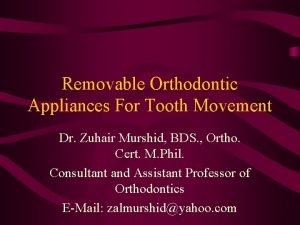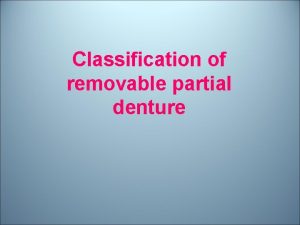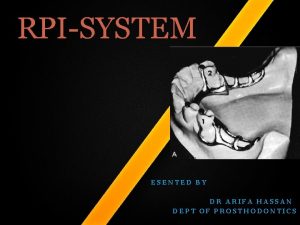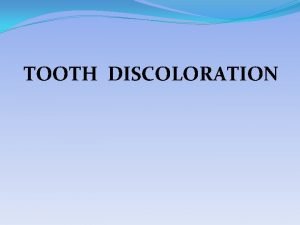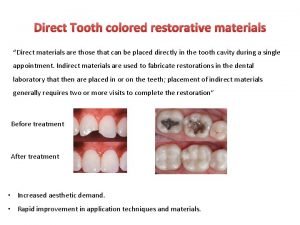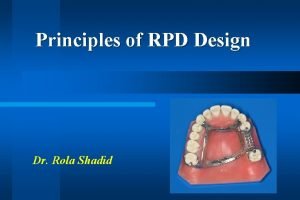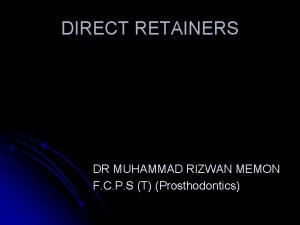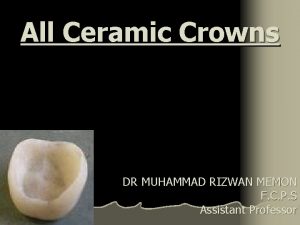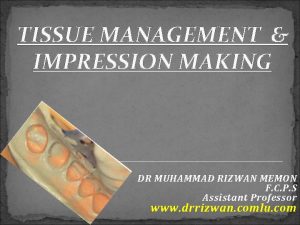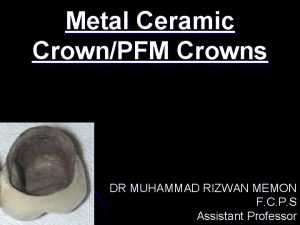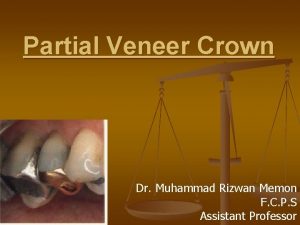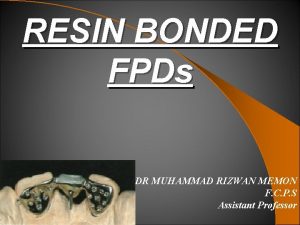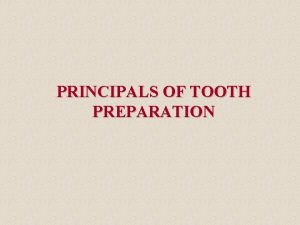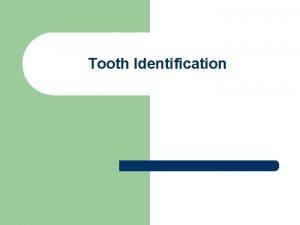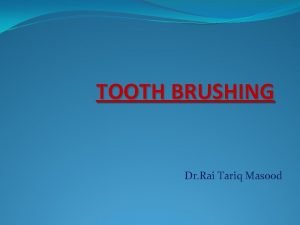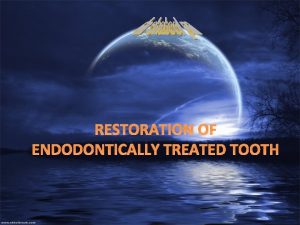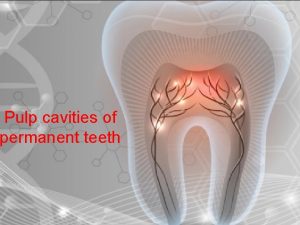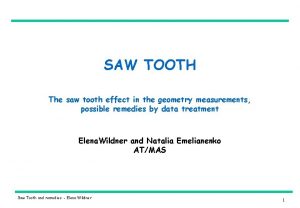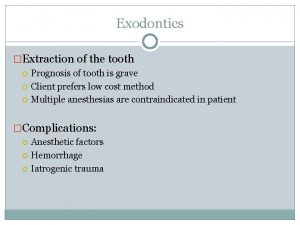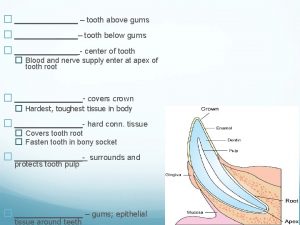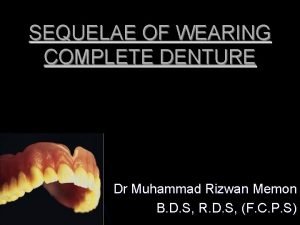Principles of Tooth Preparation DR MUHAMMAD RIZWAN MEMON














































- Slides: 46

Principles of Tooth Preparation DR MUHAMMAD RIZWAN MEMON F. C. P. S Assistant Professor

1. 2. 3. Biologic Considerations Mechanical Considerations Esthetic Considerations

Biologic Considerations

1. Prevention of damage during tooth preparation a) Adjacent teeth: leave a slight lip or fin of enamel of tooth being prepared

b) Soft tissues: damage can be prevented by aspirator tip, mouth mirror or by saliva ejector

c) Pulp l Temperature: can be controlled by high speed hand piece, feather light touch of bur and copious water spray l Chemical Action: dentine bonding agents or cavity varnish can form an effective barrier l Bacterial Action: antimicrobial mouth washes

2. Conservation of tooth structure a. Partial coverage

b) Minimum taper

c) Occlusal morphology

d) Orthodontically reposition

e. Conservative margin design

3. Considerations Affecting future dental health A. Axial Reduction: avoid excessive axial contours, crown should duplicate the contours and profile of original tooth

B. Margin Placement a) Supra gingival b) Sub gingival c) Equi gingival Supra gingival margin design Sub gingival margin design

Advantages of Supra gingival margins l l Easily finished Easily kept clean Easy impression recording Easy evaluation at followup Indications of Sub gingival margins: l l l Dental caries, cervical erosion or restorations extended sub gingivally Additional retention Esthetic Proximal contact area extends to the gingival crest Root Sensitivity

C. Margin Adaptation l l Smooth contact margins needed Metal margins fits within 10 u Porcelain margins fits within 50 u Rough, irregular and step junctions should be avoided

D. Margin Geometry/ Design: l l Feather Edge/ Knife edge (not recommended) Bevel (facial margins of PVC, inlays & onlays) Chamfer (Cast metal & lingual margins of metal ceramic restorations) Shoulder (facial margins of MC crowns & All Ceramic crowns)

Ø SHOULDERLESS (KNIFE EDGE) PREPARATION Ø Ø Ø Easy preparation Less tooth loss Pulp damage is reduced Cavosurface angle is 180 degrees Susceptible to distortion under occlusal forces May results in over contoured restorations

Ø CHAMFER PREPARATION Ø Ø Ø Suitable for cast metal / lingual surface of metal ceramic crowns More tooth tissue loss Cavosurface angle is 135 degrees with clearly defined edges

Ø SHOULDER PREPARATION Ø Ø Suitable for all ceramic / labial surface of metal ceramic More tooth surface is removed Increased pulp damage Cavosurface angle is 90 degrees

E. Occlusal Considerations

F. Preventing Tooth Fracture: l l l Inlay can act as a wedge, If the cusps are weakened, fracture may occur. Onlay provides better protection but often lacks retention. A complete crown provides the best protection against fracture. It also has the best retention

Mechanical Considerations l Retention form l Resistance form l Deformation

Retention form l The feature of a tooth preparation that resists dislodgment of a crown in a vertical direction or along the path of placement. (GPT 8 -2005)

Resistance Form l the features of a tooth preparation that enhance the stability of a restoration and resist dislodgment along an axis other than the path of placement (GPT 82005)

Retention and Resistance Form 1. Magnitude of Dislodging Forces 2. Geometry of tooth preparation l l Single path of withdrawal Cylindrical preparation

3. Taper: the convergence of two opposing external walls of a tooth preparation as viewed in a given plane. l l l Axial walls should converge occlusally More parallel opposing walls, greater retention Recommended convergence between opposing walls is 6º

4. Freedom of Displacement l Retention is improved by limiting the number of paths of insertion

5. Surface area: Longer axial walls more retention minimum length 3 mm

l Longer walls interfere with tipping displacement

l Preperation with small diameter resist pivoting better than an equal length and larger diameter

l Resistance of a short preparations can be improved by adding grooves, boxes & pinholes

6. Stress concentration: rounding the internal line angles

7. Type of preparation: retention of complete crown is double that of partial veneer crown

8. Roughness of surface being cemented

9. Type of luting agent l l Adhesive resin Glassionomer Polycarboxylate Zinc Oxide Eugenol

10. Film thickness of luting agent: 50 u is more retentive, up to 120 u is acceptable

3. Deformation: l Restoration must have sufficient strength l Alloy selection: Nickel-chromium< type IV gold alloys l Adequate tooth reduction: Axial & occlusal reduction l Functional Cusp Bevel

l Axial Reduction Overinclination: excessive cut & lessening retention Inadequate axial reduction: thin walls or overcontoured restoration

l Occlusal reduction adequate thickness of restoration mimics original anatomy

l l l Functional cusp bevel is an integral part of occlusal reduction Thin area or perforation in the casting Overcontouring and poor occlusion

Esthetic Considerations

l Facial Tooth Reduction: 1. 5 mm Reduction Two plane reduction

l Incisal Reduction: Restored without metal backing 2 mm reduction

l Proximal reduction: Restored without metal backing

l Labial Margin Placement l Sub gingival margins for esthetic reasons especially in high lip line patients

 Principles of tooth prep
Principles of tooth prep Rmaah memon
Rmaah memon Bait rizwan
Bait rizwan Dr raja rizwan
Dr raja rizwan Conical pontic
Conical pontic Raja 105
Raja 105 Rizwan qamar
Rizwan qamar An eye for an eye a tooth for a tooth sister act
An eye for an eye a tooth for a tooth sister act Ilayka anta sabahi
Ilayka anta sabahi Ata hi yatu
Ata hi yatu G v black classification
G v black classification Secondary retention and resistance form
Secondary retention and resistance form Access cavity preparation grossman
Access cavity preparation grossman Counter bevel onlay
Counter bevel onlay Axial wall depth
Axial wall depth Bur design
Bur design Skirts in cast gold restoration
Skirts in cast gold restoration Functional cusp bevel of mandibular molar
Functional cusp bevel of mandibular molar Cast metal restorations
Cast metal restorations Class 5 tooth preparation
Class 5 tooth preparation Slot preparation
Slot preparation Occlusal rest rpd
Occlusal rest rpd Isthmus tooth preparation
Isthmus tooth preparation Initial tooth preparation stage
Initial tooth preparation stage Skirt preparation in conservative dentistry
Skirt preparation in conservative dentistry Digestive system
Digestive system Is an egg a chicken embryo
Is an egg a chicken embryo This tooth kill me lately
This tooth kill me lately Maxillary teeth
Maxillary teeth Squint test in complete denture
Squint test in complete denture Classification of retainers in fpd
Classification of retainers in fpd Ellis tooth fracture
Ellis tooth fracture Class 3 removable partial denture
Class 3 removable partial denture Fränkel 2 appliance uses
Fränkel 2 appliance uses Difference between nursing bottle caries and rampant caries
Difference between nursing bottle caries and rampant caries Height of contour of tooth
Height of contour of tooth Contraindications of tooth extraction
Contraindications of tooth extraction Gear tooth profile
Gear tooth profile Cross tooth balance
Cross tooth balance Component of adam clasp
Component of adam clasp Partial denture classification
Partial denture classification Canine tooth
Canine tooth Rpa vs rpi clasp
Rpa vs rpi clasp Classification of tooth discoloration
Classification of tooth discoloration What is this called
What is this called Tooth colored restorative materials
Tooth colored restorative materials Rpd reciprocal arm
Rpd reciprocal arm
